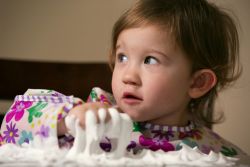It is March Break in your neck of the woods and the children are all very excited to spend some time out of school. We all know the most popular activities are ones that can be done outside burning off all that extra energy. While we fully agree with that, you may live in a climate where spending large amounts of time outside during the March Break is just not feasible due to cold weather and frostbite advisories. We all like to think that by March, it starts to get warmer outside but that is not always the case!
For those days where you have to remain indoors we have put together a list of four of our favourite sensory activities from our days as Childcare Providers. These can all be done indoors within the comfort of your own home. The best part is that your children will be learning through play while you sit back with your coffee and enjoy watching them have fun!
Goop
What you will need:
- Cornstarch (approximately 1 ½ cups)
- Water (approximately ¼ cup)
- Food colouring or paint (optional)
- A sensory bin or small container (We use clear, under bed storage containers)
- Measuring cups, spoons, funnels, spoons etc
Here’s how to do it:
Pour the Cornstarch into your bin, mix in the water and stir it up with a spoon or have your children mix it with their fingers. For added fun, you can add a few drops of paint and let them have fun mixing, pouring and manipulating it with the tools that they are using!
Tip: To modify this for older children, you can get them to make their own goop by giving them the ingredients required. You can allow them the space to experiment to find out what happens when they add more water or more cornstarch. You can also give them the paint and allow them to mix colours.
* Goop can be a little intimidating for adults, as it looks very messy. However, it has properties that allow it to be both solid and liquid which makes it quite easy to sweep up when it dries.
Tapioca Pearls Sensory Beads
What you will need:
- Large tapioca pearls
- Water
- A strainer
- Food colouring (optional)
- A pot
- A sensory bin
- Toy sea creatures, measuring cups, funnels, ladles etc...
Here’s how to do it:
Cook the Tapioca Pearls according to the instructions on the package. Drain them and add some food colouring if desired. Add the tapioca pearls into your sensory bin with some water or by themselves if preferred. You can add some different colours and a few drops of peppermint or vanilla extract to make it more stimulating for their senses.
*Tapioca Pearls are what is used for Bubble Tea and can be found at most Asian Supermarkets.
Coloured Rice Hide and Seek
What you need:
- Uncooked rice
- Re-sealable, clear bags
- Food colouring
- Vinegar
- Cookie sheet
- Parchment paper
- Objects from around your house: fake bugs, little toys, magnetic letters etc...
- A sensory bin
Here’s how to do it:
Step 1:To colour the rice, fill a re-sealable, clear bag with rice and add a few drops of food colouring with a teaspoon of vinegar. Shake and squish the bag to mix the food colouring into the rice. Once it has been mixed, lay the rice to dry on a cookie sheet lined with parchment paper. Repeat these steps to make different colours of rice.
Step 2: Once the rice has dried, add it all to your container. Find items around your house that you can hide in the rice for your children to find. Let them explore the rice while searching for the hidden objects. For added fun, you can write out a list of the hidden objects for them to search for.
Tip: To make this age appropriate for younger non-readers you can take a picture of the objects that they are to search for.

Ice and Snow
What you will need:
- Containers of any size
- Water
- A sensory bin
- Objects from around your home
- Snow (optional)
- Food colouring (optional)
- Thin gloves or mitts
- Towels or tablecloth for under the bin
- Spoons, paintbrushes, warm water, little shovels, pails etc...
Here’s how to do it:
Step 1: Fill your containers with water (coloured water is optional.) Place some small objects inside the container and place it in the freezer or outside if the temperature is cold enough.
Step 2: Once they are frozen, put the ice blocks inside of your sensory bin and let the children chip away at them with their spoons or whichever tools they have. You can fill a cup with warm water and let them paint the ice with warm water or pour the water over the ice to allow them to observe what happens. For added fun, put some snow into the sensory bin and let them have fun with snow inside!
Follow up questions
Here are some follow up questions that you can ask your children to enrich their learning experience while doing these activities:
- What does it smell like?
- What does it feel like?
- What happens when you squish it in between your fingers?
- Is it cold, hot, warm?
- What shapes and colours can you see?
Writing down their answers will be a fun memory to look back on as they get older!
What children learn through sensory play
Beyond allowing children the opportunity to have fun and make a mess, sensory activities have many added learning benefits. They help children develop their creative side by providing them with open-ended activities so that they can create their own masterpieces. While touching, manipulating and smelling the activities, they are developing their senses and while mixing, pouring and dumping they are learning about math, developing their fine motor skills and hand/eye coordination. Sensory activities are a great way to develop a child’s social emotional development as it gives them ample opportunities to learn about cooperation and working as a team.






